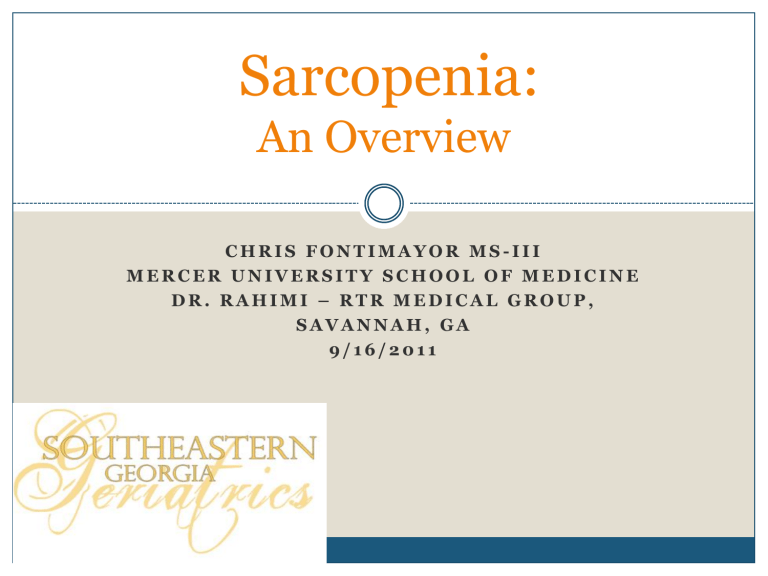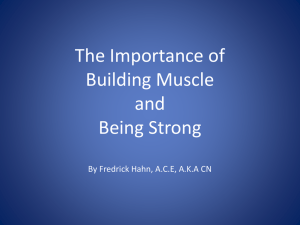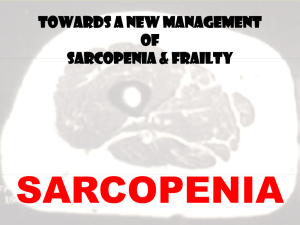An Overview on Sarcopenia

Sarcopenia:
An Overview
C H R I S F O N T I M A Y O R M S - I I I
M E R C E R U N I V E R S I T Y S C H O O L O F M E D I C I N E
D R . R A H I M I – R T R M E D I C A L G R O U P ,
S A V A N N A H , G A
9 / 1 6 / 2 0 1 1
Sarcopenia
20 years old
“The age-associated loss of skeletal muscle mass and function”
Cachexia – disease-related loss of body mass
Muscle mass decreases by approximately 6% per decade in the average person beginning at age 45
Prevelance estimations are 5-13% of 60-70 year olds and
11-50% in population older than 80
Estimated direct health care cost attributable to sarcopenia in the U.S. in 2000 was $1.5 billion
Diagnosis and treatment is not a standard part of the geriatric care in the U.S. as it is in Europe
No clear consensus on definition or diagnosis
Sarcopenia
No reliable markers to distinguish true age-specific sarcopenia from other forms of muscle wasting (ie cachexia)
Muscle wasting in older patients is almost always a combined effect of aging and disease
Data has shown that muscle mass is not necessarily linear with muscle function
Health ABC Study – muscle function is a better predictor of adverse outcomes than muscle mass
Combination of both variables is helpful in studies
Mechanisms of Saropenia
Atrophy and loss of skeletal muscle, mainly type II fibers
Increased type I fibers increase endurance BUT decreased strength
Imbalance between protein synthesis and degradation rates
Positive/negative nitrogen balance
Still unknown whether sarcopenia in elderly is an inevitable result of aging or due to a combination of illness, poor nutrition, inactivity, etc.
Etiologic Factors
Inactivity
Increased muscle fat
Insulin resistance
Loss of alpha motor neurons
Decreased protein intake
Increased IL-6
Loss of estrogen or testosterone
Decreased growth hormone secretion
Diagnostic Criteria
The European Society of Parenteral and Enteral Nutrition Special
Interest Groups
Low muscle mass – percentage of muscle mass > 2 SDs below the mean in individuals aged 18-39 in the National Health and Nutrition Examination Survey
III Cohort
Walking speed <0.8 m/s in the 4-meter walk test or reduced performance in any functional test used to assess the geriatric population
The European Working Group on Sarcopenia in Older People
Low muscle mass
Low muscle strength, eg, grip strength
Low physical performance, eg, gait speed
The International Working Group on Sarcopenia
Gait speed < 1m/s
Objectively measured low muscle mass
Measurement techniques
Dual-energy X-ray absorptiometry (DXA)
Bioelectric impedance analysis (BIA)
Consequences of Sarcopenia
Loss of functional status
New Mexico Elder Health Survey
Appendicular skeletal muscle mass (ASMM) estimated using a prediction equation (weight, height, hip circumference, grip strength, gender)
Sarcopenia – ASMM/height² <7.26 for males and <5.45 for females
Sarcopenia was significantly associated with a three to four-fold increase risk of self-reported physical disability
National Health and Nutrition Examination Survey
Sarcopenia defined by the ratio of skeletal muscle mass by bioelectrical impedance divided by total body mass
Sarcopenic participants reported an increased need for assistance with activities of daily living
Consequences of Sarcopenia
Loss of functional status
Other epidemiologic studies note no association
Recent cross sectional study
109 men and women over the age of 60
Sarcopenia measured by Dual-emission X-ray absorptiometry
(DXA) was not associated with self-reported functional limitations
EPIDOS study
Women above the age of 75
Extrapolated data showed no association between sarcopenia and decline in activities of daily living
Consequences of Sarcopenia
Loss of functional status
Only one study examined CHANGES in body composition and its relationship with self-reported loss of daily function in the elderly
97 women (71.4) and 62 men (71.6)
DXA analysis and report of disability level at baseline, 2 years, 5.5 years
Participants with loss of ASMM (cut-off at median change in muscle mass) had a 2.15-fold increased risk of having a worsening disability compared to those whose ASMM remained stable
Further research needed due to differing results of studies
Consequences of Sarcopenia
Fall Risk
Not much data on relationship between muscle mass in old age and risk of falls (2 major studies, retrospective, 12 months)
New Mexico, 883 elderly, sarcopenic Hispanic and Non Hispanic white males and females with mean age of 74
22% of males and 31% of females reported a fall in the past year
After adjustment for confounding factors, the odds ratio for falls in males was statistically significant but not in females
MINOS study – 796 males aged 50 to 85
25.4% reported falls in the past year
After adjustment for confounding factors, the odds ratio per SD lower of relative appendicular muscle mass (RAMM) was 1.31
Men in the highest tertile for RAMM were less likely to report falls in the previous year than those in the lower quartile for RAMM
Consequences of Sarcopenia
Fall Risk
Problem with the 2 studies being retrospective
Cannot exclude muscle mass has declined as a result of the fall
Warrants prospective studies on the relationship between loss of muscle mass and fall risk
Consequences of Sarcopenia
Mortality
1396 men and women aged 70 years and older
After confounding adjustments, low arm muscle area (≤21.4 cm² for men and ≤21.6 cm² for women) was associated with an 8 year mortality risk ( hazard ratio (HR)= 1.95)
957 community-dwelling Japanese men and women aged 65 to
102 years old
Low arm muscle area (<23.5 cm²) was associated with a higher mortality risk (HR=2.03) compared to high muscle area (≥33.4 cm²)
236 people died before the 2 year follow up
Consequences of Sarcopenia
Mortality
4107 British men aged 60 to 79 years old
Low mid arm muscle circumference was associated with an increased risk of mortality during a 6-year follow up
Many more large studies demonstrating that low upper body muscle mass is associated with an increased risk of mortality in elderly men and women
Consequences of Sarcopenia
Mortality
Recently, large epidemiologic studies have been using more accurate measures of skeletal muscle mass
Health, Aging and Body composition study
2292 well functioning men and women aged 70 to 79
Leg skeletal muscle mass measured with DXA and mid-thigh muscle cross-sectional area from CT scan
Confounding factors were adjusted for
Low mid-thigh muscle area was associated with increased mortality risk for men (per SD of 28.1 cm² lower muscle area the
HR was 1.26)
This risk not found in women (HR=0.94)
Mean follow up was 4.9 years in which 286 people died
Consequences of Sarcopenia
Mortality
InChianti study
934 Italian men and women aged 65 or older
Muscle cross-sectional area of the calf with quantitative CT scan
After adjustment for confounders, no increased risk of mortality for low muscle mass
Muscle density of calf not related to mortality risk
715 French men and women aged 50 to 85 years
Baseline appendicular skeletal muscle mass was not associated with increased mortality when adjusted for confounding factors
Consequences of Sarcopenia
Mortality
Framingham Heart Study and MINOS study
Prospective studies that examined the CHANGE in muscle mass over time and its relationship with mortality risk
Both showed that accelerated muscle mass loss is a risk factor for mortality in the elderly
Heterogeneity in the literature
Further research is warranted
Pharmacologic Treatment
Hormonal Approach
Testosterone
Increases the rate of muscle protein synthesis and # of muscle satellite cells
In hypogonadal elderly men, has been shown to increase muscle mass and strength and to decrease fat mass
BUT inconclusive results from studies evaluating effectiveness in muscle strength and functionality in community-dwelling populations
A 2006 meta-analysis of 11 studies suggested a moderate increase in muscle strength
Healthy men aged 60 to 80 with low testosterone
Testosterone replacement therapy over 6 months showed increases in lean muscle mass, but no improvement in strength and function
Large clinical trials are necessary
Pharmacologic Treatment
Hormonal Approach
Growth hormone (GH)
Promotes muscle growth via insulin-like growth factor I (IGF-I)
30% of men older than 60 years are GH deficient
In elderly men, many clinical trials show no additional benefit of
GH in combination with exercise or testosterone therapy
Possibly due to small sample size, lack of pulsatile pattern of GH administration, high incidence of side effects
However, other studies report that a few months of GH therapy significantly increases lower extremity muscle strength and mass in healthy, elderly men and women
Further research needed
Pharmacologic Therapy
Hormonal Approach
Estrogen
Some evidence links estrogen replacement to muscle mass and strength
Few clinical trials included older women
5 clinical trials assessed the effect of estrogens on muscle strength in women
3 reported statistically significant improvement in muscle strength, 2 studies were negative
Pharmacologic Treatment
Hormonal Approach
Vitamin D
Hypovitaminosis D has a high prevelance in the elderly population
Proximal muscle weakness is a clinical symptom of Vit. D deficiency
Nutritional recommendations for sarcopenia are to measure levels and provide supplementation if less than 100 nmol/L
Several randomized controlled trials have reported Vit. D supplementation improves muscle strength
In people aged 65 and above, 800 IU of Vit. D3 significantly improves lower extremity strength and function by 4% to 11% and body sway by 28% after 2 to 12 months of therapy
A recent meta-analysis reported that 700-1000 IU/day reduces fall risk by 19% in the elderly
Pharmacologic Treatment
Hormonal Approach
Myostatin Inhibitors
Myostatin decreases protein synthesis leading to decreased muscle cell synthesis
Follistatin – myostatin-binding protein, recombinant Abs against myostatin, activin type IIB receptor (ActRIIB-Fc) - soluble myostatin decoy receptor
Animal models show promise, however experts report muscle tissue may be more susceptible to injury in mice with myostatin deficiency
A randomized, double-blind, phase I study on healthy postmenopausal women demonstrated a 2.4-2.6% increase in muscle mass after 15 days of treatment with ActRIIB-Fc
Pharmacologic Treatment
Statins
In a longitudinal study performed on community dwelling elderly adults, statin therapy was associated with declines in muscle strength and increased risk of falls
However, this was not confirmed by other authors
There is a consensus that statins increase appendicular lean muscle mass, especially after resistance training
Small tissue injury local release of growth factors muscle hypertrophy
Further studies are needed to assess the effect of statins on muscle strength and functionality
Pharmacologic Treatment
Creatine
Increases energy storage via increasing intramuscular phosphocreatine
Benefits on exercise performance in young adults are welldocumented
Few trials on the elderly population
Mixed results on increases in muscle mass and strength
Physical Activity
Partially reverses the age-related declines in muscle mass and dysfunction
Summary
Sarcopenia is a possible major cause of frailty and disability in the elderly population
Fresh research topic that needs increased attention and awareness
Further research will improve care and treatment to help lower health care costs related to sarcopenia
The hope is for a consensus on sarcopenia routine part of clinical practice
References
Rolland, Yves (editor). Sarcopenia. Clinics in
Geriatric Medicine, August 2011; 27 (3); 341-482.









